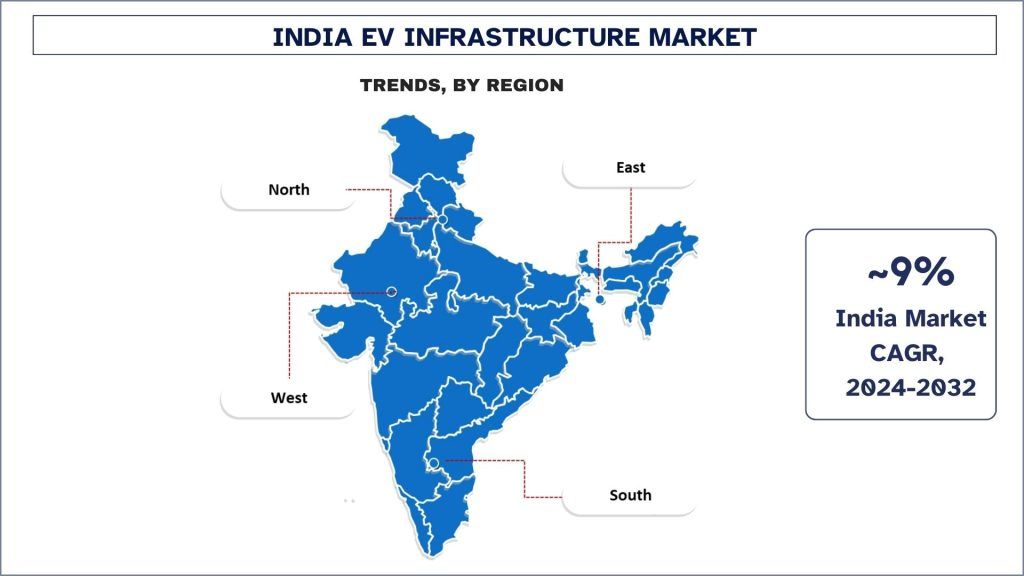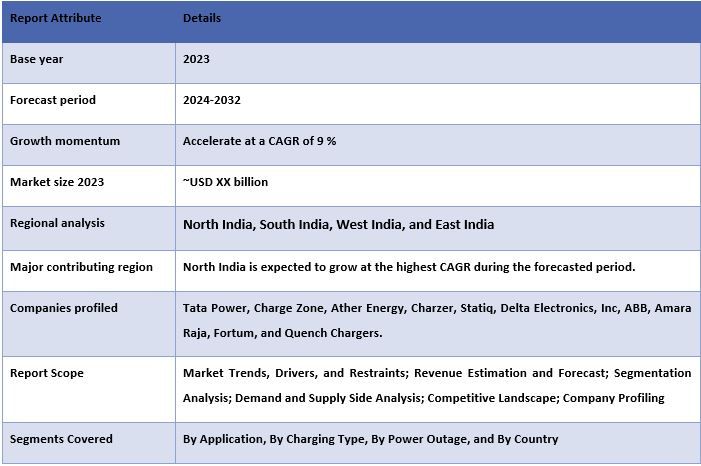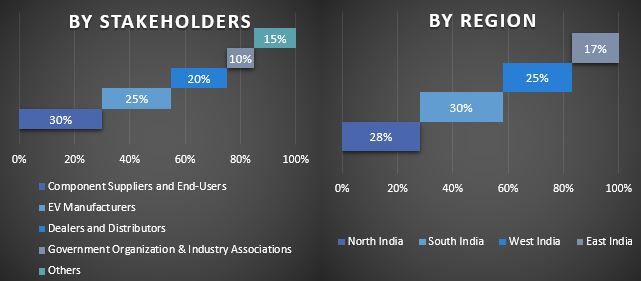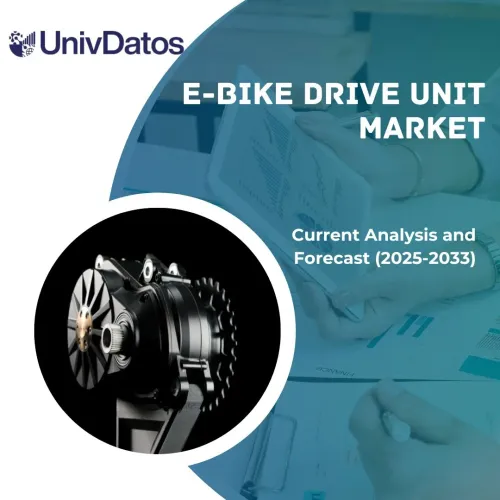インドのEVインフラ市場:現状分析と予測(2024年~2032年)
用途(公共および私用);充電タイプ(急速および普通);電力出力(22KW未満および22KW超);および地域/国
インドEVインフラ市場規模と予測
インドのEVインフラ市場は、2023年に約XX億米ドルと評価され、都市化の進展、手頃な価格、可処分所得の増加、電気自動車への移行により、予測期間(2024〜2032年)中に約9%の堅調なCAGRで成長すると予想されています。
インドEVインフラ市場分析
EV車をサポートする主な要因は、EVインフラです。これには、公共および民間のセクターのバッテリー充電ステーション、充電タイプ、急速充電ステーション、接続、および高速充電ステーションが含まれます。したがって、輸送からの有毒ガスおよび有害ガスの割合が増加しているため、電気自動車の採用が必要です。さらに、政府は地域を緑豊かで環境に優しく保つための規則と規制も実施しています。充電インフラの普及は、EVの普及に不可欠です。さらに、市場の主要企業はEVインフラのネットワークを強化するために取り組んでいます。たとえば、2022年には、Hyundai Motor India Limited(HMIL)とTata Powerが提携し、全国の電気自動車(EV)充電インフラの範囲を拡大し、インドの29都市にある34のEVディーラーの場所にDC 60 kWの急速充電器を設置すると発表しました。
インドEVインフラ市場動向
このセクションでは、当社の調査専門家が特定した、インドのEVインフラセグメントに影響を与える主要な市場動向について説明します。
公共セグメントが業界を変革
アプリケーションに基づいて、市場は公共と民間に分類されます。公共部門は、予測期間中に高いCAGRを示すでしょう。これは、EVの採用を促進するために公共の急速充電器が広く使用されているためです。さらに、さまざまなOEMおよびEVグリッドオペレーターは、小売店、ホスピタリティ施設、駐車場、政府機関、道路、ガソリンスタンドなどの場所に公共の急速充電器を設置しています。ただし、ほとんどのEVインフラストラクチャは、顧客の利益のために一般に公開されています。

北インドが2023年に市場を支配
北インドにおけるEVインフラ市場の成長は、主にFAME IIスキームなどの政府の取り組みと、充電ステーションの開発を奨励するさまざまな州レベルの政策によって推進されています。デリー、グルガオン、ノイダなどの主要地域の都市化およびスマートシティプロジェクトは、持続可能な都市計画の一環としてEVインフラを統合しています。消費者の間で環境意識が高まっていることが、特に二輪車および三輪車セグメントでの電気自動車の採用を促進しており、アクセス可能な充電ソリューションの需要を押し上げています。政策支援、都市開発、EV採用の増加が組み合わさることで、この地域でのEVインフラの強力な成長機会が生まれています。

インドEVインフラ業界の概要
インドのEVインフラは競争が激しく、多くのインドおよび国際的な市場プレーヤーが存在します。主要なプレーヤーは、パートナーシップ、契約、コラボレーション、新製品の発売、地理的な拡大、M&Aなど、市場での存在感を高めるためにさまざまな成長戦略を採用しています。市場で活動している主要なプレーヤーには、Tata Power、Charge Zone、Ather Energy、Charzer、Statiq、Delta Electronics、Inc、ABB、Amara Raja、Fortum、Quench Chargersなどがあります。
インドEVインフラ市場ニュース
- たとえば、2024年、e-モビリティソリューションに焦点を当てたテクノロジー企業であるKazamは、シリーズA3資金調達ラウンドで800万ドルを確保しました。この投資は、Vertex Ventures Southeast Asia and Indiaが主導し、Avaana Capital、Alteria Capital、およびその他の投資家が参加しました。
- Kazamは、シリーズA3の資金調達を行い、インドで成長する電気自動車市場全体で革新的な充電ソリューションを拡大し、航続距離の不安に対処し、統合されたソフトウェアおよびハードウェアプラットフォームを通じて国のEV導入をサポートすることを目指しています。
インドEVインフラ市場レポートの対象範囲

このレポートを購入する理由:
- この調査には、認証された主要な業界専門家によって検証された市場規模と予測分析が含まれています。
- このレポートは、業界全体のパフォーマンスの概要を一目で示します。
- このレポートでは、主要な事業財務、製品ポートフォリオ、拡張戦略、最近の開発に重点を置いて、著名な業界ピアの詳細な分析を取り上げています。
- 業界で普及している推進要因、抑制要因、主要なトレンド、機会の詳細な調査。
- この調査では、さまざまなセグメントにわたる市場を包括的にカバーしています。
- 業界の詳細な地域レベルの分析。
カスタマイズオプション:
インドのEVインフラストラクチャは、要件またはその他の市場セグメントに応じてさらにカスタマイズできます。これに加えて、UMIはお客様独自のビジネスニーズがあることを理解しています。したがって、お客様の要件に完全に適合するレポートを入手するには、お気軽にお問い合わせください。
目次
インドEVインフラ市場分析(2022年~2032年)の調査方法
インドEVインフラ市場の過去の市場を分析し、現在の市場を推定し、将来の市場を予測することは、主要地域におけるインドEVインフラの導入を創出し分析するために実施された3つの主要なステップでした。 過去の市場数値を収集し、現在の市場規模を推定するために、徹底的な二次調査が実施されました。 次に、これらの洞察を検証するために、多数の調査結果と仮定が考慮されました。 さらに、インドEVインフラ市場のバリューチェーン全体にわたる業界の専門家との徹底的な一次インタビューも実施されました。 一次インタビューを通じて市場数値を仮定および検証した後、トップダウン/ボトムアップアプローチを採用して、市場全体の規模を予測しました。 その後、市場の内訳とデータ三角測量の手法を採用して、業界のセグメントとサブセグメントの市場規模を推定および分析しました。 詳細な方法論を以下に説明します。
過去の市場規模の分析
ステップ1:二次情報源の詳細な調査:
インドEVインフラ市場の過去の市場規模を取得するために、年次報告書と財務諸表、業績プレゼンテーション、プレスリリースなどの企業内部情報源、およびジャーナル、ニュースと記事、政府刊行物、競合他社の刊行物、セクターレポート、サードパーティデータベース、その他の信頼できる刊行物を含む外部情報源を通じて、詳細な二次調査が実施されました。
ステップ2:市場セグメンテーション:
インドEVインフラの過去の市場規模を取得した後、主要地域のさまざまなセグメントとサブセグメントの過去の市場の洞察とシェアを収集するために、詳細な二次分析を実施しました。 主要なセグメントは、アプリケーション、充電タイプ、停電、地域など、レポートに含まれています。 さらに、その地域におけるテストモデルの全体的な採用を評価するために、国レベルの分析を実施しました。
ステップ3:要因分析:
さまざまなセグメントとサブセグメントの過去の市場規模を取得した後、インドEVインフラ市場の現在の市場規模を推定するために、詳細な要因分析を実施しました。 さらに、アプリケーション、充電タイプ、停電、インドEVインフラ地域などの従属変数と独立変数を使用して、要因分析を実施しました。 世界中のインドEVインフラ市場セクターにおけるトップパートナーシップ、M&A、事業拡大、製品発売を考慮して、需要と供給側のシナリオについて徹底的な分析を実施しました。
現在の市場規模の推定と予測
現在の市場規模の測定:上記の3つのステップからの実用的な洞察に基づいて、インドEVインフラ市場の現在の市場規模、主要なプレーヤー、およびセグメントの市場シェアに到達しました。 必要な割合のシェア分割と市場の内訳はすべて、上記の二次的アプローチを使用して決定され、一次インタビューを通じて検証されました。
推定と予測:市場の推定と予測のために、利害関係者が利用できる推進要因と傾向、制約、および機会を含むさまざまな要因に重みが割り当てられました。 これらの要因を分析した後、関連する予測手法、つまりトップダウン/ボトムアップアプローチを適用して、主要市場全体のさまざまなセグメントとサブセグメントについて、2032年の市場予測に到達しました。 市場規模の推定に採用された調査方法には、以下が含まれます。
- 収益(USD)の観点からの業界の市場規模、および国内の主要市場全体でのインドEVインフラの採用率
- 市場セグメントとサブセグメントのすべての割合のシェア、分割、および内訳
- 提供される製品の観点からのインドEVインフラの主要プレーヤー。 また、急速に成長する市場で競争するためにこれらのプレーヤーが採用した成長戦略
市場規模とシェアの検証
一次調査:主要地域全体のトップレベルのエグゼクティブ(CXO / VP、営業部長、マーケティング部長、オペレーション部長、地域部長、カントリーヘッドなど)を含む、主要なオピニオンリーダー(KOL)との詳細なインタビューを実施しました。 次に、一次調査の結果を要約し、述べられた仮説を証明するために統計分析を実行しました。 一次調査からのインプットは二次調査の結果と統合され、その結果、情報が実用的な洞察に変わりました。
さまざまな地域における一次参加者の分割

市場エンジニアリング
データ三角測量の技術を採用して、市場全体の推定を完了し、インドEVインフラストラクチャの各セグメントとサブセグメントの正確な統計数値を導き出しました。 インドEVインフラ市場のアプリケーション、充電タイプ、停電、および地域におけるさまざまなパラメータと傾向を調査した後、データをいくつかのセグメントとサブセグメントに分割しました。
インドEVインフラ市場調査の主な目的
インドEVインフラの現在および将来の市場動向は、調査で正確に示されました。 投資家は、調査で実施された定性的および定量的な分析に基づいて、投資に関する判断を下すための戦略的な洞察を得ることができます。 現在および将来の市場動向により、地域レベルでの市場全体の魅力が決定され、産業参加者が未開拓市場を開拓して、ファーストムーバーの利点を享受するためのプラットフォームが提供されます。 調査のその他の定量的な目標は次のとおりです。
- 金額(USD)の観点から、インドEVインフラ市場の現在および予測市場規模を分析します。 また、さまざまなセグメントとサブセグメントの現在および予測市場規模を分析します。
- 調査のセグメントには、アプリケーション、充電タイプ、停電、および地域が含まれます。
- インドEVインフラストラクチャの規制の枠組みを定義および分析する
- さまざまな仲介業者の存在を伴うバリューチェーンを分析するとともに、業界の顧客と競合他社の行動を分析します。
- 主要地域におけるインドEVインフラ市場の現在および予測市場規模を分析します。
- レポートで調査された主要地域には、北インド、西インド、南インド、東インドが含まれます。
- インドEVインフラ市場の企業プロファイル、および急速に成長する市場で生き残るために市場プレーヤーが採用した成長戦略。
- 業界の詳細な地域レベルの分析。
よくある質問 よくある質問
Q1: インドのEVインフラの現在の規模と成長の可能性は何ですか?
Q2:インドEVインフラ市場の成長を牽引する要因は何ですか?
Q3: アプリケーション別に見ると、インドのEVインフラで最大のシェアを占めているセグメントはどれですか?
Q4: インドEVインフラ市場における新たな技術とトレンドは何ですか?
Q5:どの地域がインドEVインフラ市場を支配するでしょうか?
関連 レポート
この商品を購入したお客様はこれも購入しました











